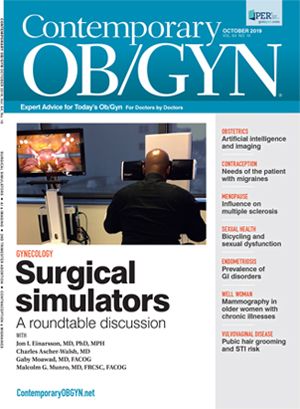Fake news in ob/gyn
As patients are exposed to more and more misinformation, ob/gyns have a responsibility to not just treat but also educate.
©Sutipond Stock - stock.adobe.com

"Facts” about women’s health that are simply untrue can wreak havoc with the doctor/patient relationship but ob/gyns can help protect women from taking clickbait.
The term “fake news” has dominated our political landscape for the past 3 years, but it has a long and infamous history. The “yellow journalism” that infested the coastal cities in New York and California at the turn of the 20th century was believed to have led to the US entry into the Spanish-American War.1 The remnants of this type of sensational print reporting can still be seen in supermarket tabloids, with ludicrous headlines about alien abductions and other nonsense.
The new normal for many of us is that we get our daily information about the world around us from our personal computers, those devices that are always, always attached to us and that can also make phone calls. The sites from which we seek information often require minimal to no verification. To continue to exist, they must maximize their “hits” to generate advertising revenue. The site and the advertisers, depending upon exactly how we have logged in, next use our pattern of clicks to feed us more and more information geared to our apparent personal tastes, as deciphered by a machine-learning algorithm. The eventual result is a barrage of information that contains variable and unknown amounts of disinformation-”fake news”-that we either sift through and try to verify (very rarely), accept and await verification from a second source (hazardous when your content is being curated by a computer that is trying to give you what it thinks you want see), or sink into a funk of cynicism and disbelief of everything and disengage (common response).
Our inherent belief in our rational ability to sort information, especially when it is now vast and readily accessible, is not well founded.2 We are, therefore, all vulnerable to defective processing and acquisition of “facts” that are simply untrue. As we become further and further insulated within our Internet-curated bubble of beliefs, we may also choose to call unwanted information feeds “fake news” even when they are true, because they don’t appear representative of all else we have been reading. Clearly, the hazards of these patterns of behavior are evident in many walks of life and are considered responsible for our current deeply divided political atmosphere.
Obstetrics and gynecology is a very personal and powerful field. We are privy to the most private details of our patients’ lives and have the ability to influence future generations with actions that we take today. The trust relationship that we have with our patients is essential to our effectiveness. The ability of fake news to wreak havoc with this trust relationship is a threat to our life’s work that can be, at times, simply annoying, but can take some very negative turns. What follows are a few examples that illustrate “fake news” in its various forms.
1. Women no longer have to endure the ravages of menopause! (Part 1)
Just a few weeks ago, The Guardian published a story online touting a new medical procedure that “could delay menopause by 20 years”.3 Two smiling, jogging midlife women are shown. The procedure promises to improve women’s lives by “delaying the onset of more common symptoms of the menopause, which range from low mood, anxiety and difficulty sleeping, to hot flushes, night sweats and a reduced sex drive.” But that’s not all! “Doctors claim the operation could benefit thousands of women who experience serious health problems, such as heart conditions and bone-weakening osteoporosis, that are brought on by the menopause.”
Wait, what?!? Something has gone wrong in the worldwide race for clicks if we are talking about creating a world where menopause occurs at age 70+. Prolonged lifetime exposure to estradiol and progesterone is associated with increased risks of breast and endometrial cancer-risks that have been appreciated for many decades.4,5 Cardioprotection from extended ovarian function is far from proven. How can a responsible news source overstate the benefits of such a procedure? How many women would-seriously-want to undergo ovarian transplantation, which includes two surgical procedures, to delay menopause? What if the ovaries are replaced in a position where they might result in pregnancy? And decades more of menstrual periods? Ahem, no thank you.
2. Women no longer have to endure the ravages of menopause! (Part 2)
The Wonderful World of “Bioidentical Hormones” is another area where “fake news” abounds unfettered by any reality. Due to the lack of regulation and oversight for compounded hormones (which were exempted from being considered pharmaceuticals but rather are considered dietary supplements, thanks to the Dietary Supplement Health and Education Act of 1994-thank you, Senator Orrin Hatch), there is almost no need whatsoever to provide any proof of claim, and penalties for false advertising are rarely imposed. Here are some claims made by various websites:
- Synthetic hormones have a variety of negative side effects, but our approach to bioidentical hormone therapy, also known as BHRT, can help you avoid these.6
- Many women begin to feel the negative effects of hormone imbalances years before menopause…Our goal is to relieve the unwanted symptoms of aging caused when hormone levels are unbalanced.7
Wait, what??!!?? The “bioidentical hormone” (BHRT) industry is arguably the first and one of the most effective “fake news” enterprises in medicine. Capitalizing on the wake of the Women’s Health Initiative (WHI), which debunked the myth that estrogen and progesterone were powerful anti-aging drugs and would prevent disease, a proliferation of alternatives were born, reinventing the myth by claiming that the hormones used in the WHI were simply the wrong hormones, and the alternative products being sold had no such side effects and would, indeed, prevent aging. This marketing has been so effective that it is estimated that BHRT is currently one-third to half of the national use of menopausal hormone therapy.8
3. HPV vaccines are bad for you…and the medical establishment is covering up!
The human papillomavirus (HPV) vaccine is one of the most effective weapons in the medical armamentarium against cervical cancer, and has already demonstrated unanticipated benefits in reducing anal and oral cancers. The perfect storm of “anti-vaxxers” and religious conservative forces, who fear that vaccinating a young woman against HPV will encourage sexual promiscuity, has impeded the effective implementation and widespread use of this life-saving strategy, aided and abetted by “fake news”-some of which is promulgated by politicians.9
The digital era has made the rapid propagation of “fake news” more efficient than ever. By offering up emotionally charged campaigns, based on powerful anecdotes that are repeated over and over again, fake news gets our attention. Logic and facts are, well, boring when pitted against sensational clickbait. Truth gets replaced with “truthiness”: something that seems or feels like it is true (thank you, Stephen Colbert), so we just go with it.
How can we and our patients protect ourselves from the clickbait?
- Encourage good habits. Direct your patients to reputable sources of information at the outset of a web search. Rather than reading the first item that comes up, assuming it is the most important one, it helps to bookmark reputable websites. The American College of Obstetricians and Gynecologists, of course, is an outstanding resource, as are the Centers for Disease Control and National Institutes of Health. Many academic medical centers have readily accessible web posts on a broad range of topics in women’s health. For specialty information, the North American Menopause Society, the American Society for Reproductive Medicine, the American Society for Gynecologic Oncology, and the Hormone Health Network provide excellent, fact-based information.
- Reiterate the principles of critical thinking. Educate your patients on how to tell if a source is reliable. Are the data referenced and peer reviewed? Are clinical studies described? If they are described, were the studies registered under clinicaltrials.gov? Are the authors in the bibliography of a scientific piece all the same, small group of authors? This suggests an internally concatenating alternative reality may be behind the thinking.
- Be proactive. I like to provide my patients with specific information sources on sensitive topics prone to disinformation campaigns. I anticipate that they will be consulting “Dr. Google” as soon as they leave my office. If you have an electronic medical record, you can create dot phrases for commonly asked questions and avoid rewriting this for every similar patient scenario. Having patient education materials available in your office waiting room can also be an effective way to direct your patients to reliable sources of information.
- Fight back. Highlight for your patients some of the more outrageous examples of viral information that were subsequently proven to be untrue (e.g., the Hillary Pizzagate Conspiracy), and alert them to be critical of stories that elicit a strong emotional response. Give them tools to sort out the real from the fake (snopes.com is an excellent website for this purpose).
Like it or not, the information highway of the Internet can be a “disinformation highway” that is not under our control, but it is here to stay. Alerting patients to the pitfalls inherent in information access in this era of plentiful information may make them better at sorting it out. And like it or not, that task has now become part of our daily work if we are to promote the health of our patients. I’m off to check my Facebook feed for the week, and I hope I won’t be accosted by too many trolls!
Disclosures:
The author reports no potential conflicts of interest with regard to this article.
References:
- Campbell JW. Yellow Journalism: Puncturing the myths, defining the legacies. 2001; Greenwood Publishing Group. pp. 156–160. ISBN 0-275-96686-0.
- Ludolph R, Allam A, Schultz PJ. Manipulating Google’s knowledge graph box to counter biased information processing during an online search on vaccination: application of a technological debiasing strategy. J Med Internet Res. 2016;18: e137.
- https://www.theguardian.com/science/2019/aug/04/medical-procedure-delay-menopause
- Ketcham AS, Sindelar WF. Risk factors in breast cancer. Prog Clin Cancer. 1975;6:99-114.
- MacMahon B. Risk factors for endometrial cancer. Gynecologic Oncol. 1975; 2:122.
- https://www.biotemedical.com/bioidentical-hormone-replacement-pellet-therapy/?gclid=EAIaIQobChMIxOzulJ-K5AIVmSCtBh3dVgMZEAAYASAAEgK3u_D_BwE
- https://www.royalmedicalcenters.com/non-menopausal-women-menopause-menopause-age-early-menopause/
- Pinkerton JV, Santoro N. Compounded bioidentical hormone therapy: identifying use trends and knowledge gaps among US women. Menopause. 2015;22:926-936.
- Teoh D. The power of social media for HPV vaccination--not fake news! ASCO Educational Book, Volume 39, pages 75-78.

